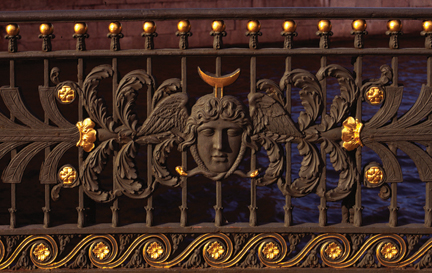In 1917 when armed Bolsheviks entered the czar’s Winter Palace in St. Petersburg to seize control of Russia, they were not thinking about the world’s largest collection of art inside. After all, it was Imperial art assembled over 150 years and had never been seen by the public. How could they possibly know that 10 million visitors a year would someday tread the same grand staircase that they climbed so anxiously that October night?
Although construction of the palace began in 1754 under Empress Elizabeth, daughter of Peter the Great, it was her successor, Catherine II, who made it look like an art gallery. Legend has it that young Catherine was walking through the palace one day when she stopped in front of a painting of “The Descent of Christ From The Cross” which had been a gift to Elizabeth. After admiring it for some time, Catherine ordered the paintings in all the Imperial residences to be brought to the Winter Palace. It was 11 years before the first museum in the United States was established in Charleston.

The Hermitage Museum
To bolster the collection, Catherine asked her ministers and foreign agents to buy all the best paintings abroad and send them to her. She subsequently purchased huge collections in Europe, gradually assembling thousands of paintings, marble statues, cameos, coins, and armor.
Most visitors walking through the Hermitage today are too overwhelmed by the art to realize that each of the 1,050 rooms is unique in its architectural moldings, window casings, ceiling design, floor paneling, and chandeliers. The building itself has 1,786 windows and 117 staircases, and stretches for nearly a kilometer along the Neva River. Seen from the outside, with river water reflected in its massive windows, the blue and white facade of this Russian-Baroque masterpiece seems to float above the ground.
This visual effect was the genius of Italian architect Bartolommeo Rastrelli who served as court architect during Elizabeth’s 20-year reign. The Hermitage — then the Winter Palace — was the fifth and final palace he designed. Rastrelli went to Russia as a boy when his father was recruited by Peter the Great. He knew only Russia for most of his life and he studied Russian orthodox churches, famous for their onion-shaped domes, to master his art. Soon after Elizabeth died in 1761, he fell out of favor because the new empress, Catherine II, preferred classical architecture. It is said that Rastrelli then traveled to Europe but returned to Russia penniless and died there.

Wrought iron work
The word “hermitage” is French and means “a secluded place.” Peter the Great had admired these formal garden retreats when he visited Europe and wanted them as a standard element in the homes of Russian noblemen. But it was Catherine II who built a pavilion in the Winter Palace known as “the small hermitage” where she could entertain private guests (who spoke French and wore French fashions) at lavish parties where servants were not allowed and where she could relax and forget her rank. Catherine later built a theater and a large pavilion (“the large hermitage”) and the name apparently stuck when the Soviets turned the Winter Palace into a national museum.
Perhaps without knowing it, Catherine II brought alive Peter the Great’s dream as she assembled her art collection and extended the palace. For in doing both, she drew emissaries, aristocrats, poets, and artists to a city that would become the leading cultural center outside Europe, and which would later attract people from as far away as South Carolina, such as Henry Middleton who in 1891 became Russian Envoy Extraordinary and Minister Plenipotentiary and spent 10 years in Russia. That was also just the beginning. St. Petersburg would eventually be the home of Pushkin, Dostoyevsky, Tchaikovsky, and Shostakovich and would boast 250 museums, 80 art galleries, and 50 theatres.
The Hermitage itself includes masterpieces by Rembrandt, Raphael, Leonardo da Vinci, Picasso, Matisse, Rubens, Titian, and El Greco. It is especially recognized for its Italian Renaissance and French Impressionist works, its Greek and Roman antiquities, and its Siberian and central Asian pieces which comprise one of the world’s largest collections of gold, jewels, and armor. To stop and actually look at every piece of art in the Hermitage, however, your vacation has to last for one year and you need to spend eight hours a day in the museum.
As you climb the spectacular white-marble staircases and step into the grand halls that were designed for thousands of guests to waltz at a time, it is hard to imagine this architectural wonder as a hospital during World War II, complete with operating rooms, a laboratory, x-ray facilities, and a dining hall. It was then, during the infamous 900-day German siege, that 650,000 citizens starved to death and 16,000 more died from bombing and shelling. Altogether, 40 million people died in Russia during the war as thousands of art works lay quietly in store in the Ural Mountains where they had been taken for safekeeping.
Survivors say that St. Petersburg was even more quiet. The streets were empty, there was no electricity or running water, and it just happened to be the coldest winter in St. Petersburg’s history. Due to the severe weather, the sea air, and no heating, all the rooms in the Hermitage were severely damaged by humidity and frost. The once gorgeous palace had been reduced to a war-torn relic of shattered glass, cracked walls, and buckling floors.
Today, however, tourists shuffle from one splendid room to the next, pausing to peer out the tall windows and gaze at the city’s cathedrals, parks, bridges, and squares onto a shimmering Neva River that sweeps downstream, reflecting today’s history of the “holy city” of Peter. •


